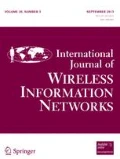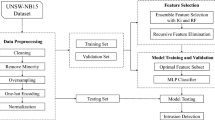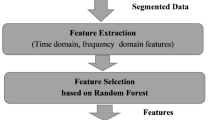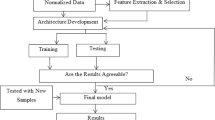Abstract
Health monitoring using Body Area Wireless Sensor Network (BA-WSN) has gained immense popularity due to usability, ubiquitous support, and real-time performance. It is a special kind of Wireless Sensor Network (WSN) that spans over the human body. Although BA-WSN is very useful but it may suffer from security and privacy issues due to compromised sensor nodes by intruders. To design a secure BA-WSN based health monitoring system, it is required to filter out malicious data packets generated by the compromised nodes. An intrusion Detection System (IDS) can be utilized for this purpose. This paper presents a Machine Learning based Intrusion Detection System (MLIDS) for BA-WSN based health monitoring framework. Specialized dataset WSN-DS has been used to train the intrusion detection model. Dataset contains four security attacks such as Blackhole attack, Grayhole attack, Scheduling attack, Flooding attack data as well as normal data packets which are simulated using Network Simulator-2. Five well-known classification algorithms such as Random Forest, kNN, SVM, J48, and Naive Bayes have been applied for the selection and generation of the best model in terms of detection accuracy. Experimental results prove that Random Forest based Intrusion Detection Model has the highest classification accuracy of 99.67%, 98.7%, 92.7%, 98.9%, 99.9% for Blackhole attack, Flooding attack, Scheduling attack, Grayhole attack as well normal packet respectively. Experimental results also show that our achieved results outperform relevant work in terms of accuracy.






Similar content being viewed by others
Data Availability
Available but not shared due to privacy.
Code Availability
Software Application.
References
S. Saif, P. Das, S. Biswas, M. Khari and V. Shanmuganathan. 5 HIIDS: Hybrid intelligent intrusion detection system empowered with machine learning and metaheuristic algorithms for application in IoT based healthcare, Microprocessors and Microsystems, Elsevier, 2022 (in-press).
P. Kaur, R. Kumar and M. Kumar, A healthcare monitoring system using random forest and internet of things (IoT), Multimedia Tools and Applications, Vol. 14, pp. 1–12, 2019.
A. Onasanya, S. Lakkis and M. Elshakankir, Implementing IoT/WSN based smart Saskatchewan healthcare system, Wireless Networkss, Vol. 25, pp. 3999–4020, 2019.
S. Saif and S. Biswas, Secure data transmission beyond tier 1 of medical body sensor network, Proceedings of International Ethical Hacking Conference, Vol. 2018, pp. 405–417, 2019.
S. Saif, R. Gupta and S. Biswas, Implementation of cloud-assisted secure data transmission in WBAN for healthcare monitoring, in: Advanced computational and communication paradigms. S. Bhattacharyya, N. Chaki, D. Konar, U. Chakraborty and C.T. Singh (eds.), pp. 665–674, Springer Singapore, 2019.
S. Saif, S. Biswas, On the implementation and performance evaluation of security algorithms for healthcare, Proceedings of the 2nd International Conference on Communication, Devices and Computing, 629–640 (2020).
K. Karmakar, S. Saif, S. Biswas, S. Neogy, WBAN Security: study and implementation of a biological key based framework, 2018 Fifth International Conference on Emerging Applications of Information Technology (EAIT), Kolkata,1–6 (2018)
Almomani and B. Al-Kasasbeh, Performance analysis of LEACH protocol under Denial of Service attacks, 2015 6th International Conference on Information and Communication Systems (ICICS), Amman, 292–297 (2015)
S. Mishra, A.K. Tyagi, Intrusion Detection in Internet of Things (IoTs) Based Applications using Blockchain Technolgy, 2019 Third International Conference on I-SMAC (IoT in Social, Mobile, Analytics and Cloud) (I-SMAC), 123–128 (2019)
G. Thamilarasu, iDetect: an intelligent intrusion detection system for wireless body area networks, International Journal of Security and Networks, Vol. 11, pp. 82–93, 2016.
S. Dahiya, M.K. Bohra, Element-key table based complex key generation (E-CKG) for IoT based health care networks, Proceedings of the 10th International Conference on Security of Information and Networks, 59–64 (2017)
G. Thamilarasu, A. Odesile and A. Hoang, An intrusion detection system for internet of medical things, IEEE Access, Vol. 8, pp. 181560–181576, 2020.
A. Bengag, O. Moussaoui, M. Moussaoui, A new IDS for detecting jamming attacks in WBAN, 2019 Third International Conference on Intelligent Computing in Data Sciences (ICDS), 1–5 (2019)
A. Bengag, A. Bengag and O. Moussaoui, A new IDS for detecting jamming attacks in WBAN, Advances in Science, Technology and Engineering Systems Journal, Vol. 5, pp. 80–86, 2020.
X. Hou, J. Wang, C. Jiang, S. Guanand, Y. Reni, A sink node assisted lightweight intrusion detection mechanism for WBAN, 2018 IEEE International Conference on Communications (ICC), 1–6 (2018)
D.K. Anguraj, S. Smys, Trust-based intrusion detection and clustering approach for wireless body area networks, Wireless Personal Communications, 1–20 (2019)
A. Odesile, G. Thamilarasu, Distributed intrusion detection using mobile agents in wireless body area networks, 2017 Seventh International Conference on Emerging Security Technologies (EST), 144–149 (2017)
S. Deya, Q. Yea and S. Sampallia, A machine learning based intrusion detection scheme for data fusion in mobile clouds involving heterogeneous client networks, Information Fusion, Vol. 49, pp. 205–215, 2019.
A. Kaanan, S. Mahajan, Detecting denial-of-service attack using dendritic cell approach, Proceedings of the Second International Conference on Information Management and Machine Intelligence, 509–516 (2021)
A. . Kore and S. . Patil, IC-MADS: IoT enabled cross layer man-in-middle attack detection system for smart healthcare application, Wireless Personal Communications, Vol. 113, pp. 727–746, 2020.
D. He, Q. Qiao, Y. Gao, J. Zheng, S. Chan, J. Li and N. Guizani, Intrusion detection based on stacked autoencoder for connected healthcare systems, IEEE Network, Vol. 33, pp. 64–69, 2019.
H. Abbas, R. Latif, S. Latif and A. Masood, Performance evaluation of Enhanced Very Fast Decision Tree (EVFDT) mechanism for distributed denial-of-service attack detection in health care systems, Annals of Telecommunications, Vol. 71, pp. 477–487, 2016.
R. Latif, H. Abbas, S. Assar and S. Latif, Analyzing feasibility for deploying very fast decision tree for DDoS attack detection in cloud-assisted WBAN, in: International conference on intelligent computing. D.-S. Huang, V. Bevilacqua and P. Premaratne (eds.), pp. 507–519, Springer International Publishing, Cham, 2014.
I. Almomani, B. Al-Kasasbeh and M. Al-Akhras, WSN-DS: a dataset for intrusion detection systems in wireless sensor networks, Journal of Sensors, Vol. 2016, pp. 1–16, 2016.
N. Mohd, A. Singh and H. S. Bhadauria, A novel SVM based IDS for distributed denial of sleep strike in wireless sensor networks, Wireless Personal Communication, Vol. 111, pp. 1999–2022, 2020.
M. Safaldin, M. Otair and L. Abualigah, Improved binary gray wolf optimizer and SVM for intrusion detection system in wireless sensor networks, Journal of Ambient Intelligence and Human Computing, Vol. 12, pp. 1559–1576, 2021.
B. Subba, S. Biswas and S. Karmakar, A game theory based multi layered intrusion detection framework for wireless sensor networks, International Journal of Wireless Information Networks, Vol. 25, pp. 399–421, 2018.
A. Golrang, A. M. Golrang, S. Yildirim Yayilgan and O. Elezaj, A novel hybrid IDS based on modified NSGAII-ANN and Random Forest, Electronics., Vol. 9, No. 4, pp. 577, 2020.
S. Waskle, L. Parashar, U. Singh, Intrusion Detection System Using PCA with Random Forest Approach, 2020 International Conference on Electronics and Sustainable Communication Systems (ICESC), 803–808 (2020)
G.D. O’Mahony, P.J. Harris, C.C. Murphy, Detecting interference in wireless sensor network received samples: a machine learning approach, 2020 IEEE 6th World Forum on Internet of Things (WF-IoT), 1–6 (2020)
J-S. Pan, F. Fan, S-C. Chu, H-Q. Zhao, G-Y. Liu. A lightweight intelligent intrusion detection model for wireless sensor networks, Security and Communication Networks 2021 (2021)
A. B. Abhale and S. S. Manivannan, Supervised machine learning classification algorithmic approach for finding anomaly type of intrusion detection in wireless sensor network, Optical Memory and Neural Networks, Vol. 29, No. 3, pp. 244–256, 2020.
Otoum, B. Kantarci, H.T. Mouftah, A novel ensemble method for advanced intrusion detection in wireless sensor networks, ICC 2020–2020 IEEE International Conference on Communications (ICC), 1–6 (2020)
S. E. Quincozes, J. F. Kazienko, Machine learning methods assessment for denial of service detection in wireless sensor networks, 2020 IEEE 6th World Forum on Internet of Things (WF-IoT), 1–6 (2020)
M. Al-Akhras, A.I. Al-Issa, M.S. Alsahli, M. Alawairdhi. POSTER: feature selection to optimize DoS detection in wireless sensor networks, 2020 First International Conference of Smart Systems and Emerging Technologies (SMARTTECH), 263–265 (2020)
A.I. Al-issa, M. Al-Akhras, M.S. ALsahli, M. Alawairdhi, Using machine learning to detect DoS attacks in wireless sensor networks, 2019 IEEE Jordan International Joint Conference on Electrical Engineering and Information Technology (JEEIT), 107–112 (2019)
A.A. Sallam, M.N. Kabir, Y.M. Alginahi, A. Jamal, T.K. Esmeel. IDS for improving DDoS attack recognition based on attack profiles and network traffic features, 2020 16th IEEE International Colloquium on Signal Processing & Its Applications (CSPA), 255–260 (2020)
A. S. Talita, O. S. Nataza and Z. Rustam, Naïve Bayes classifier and particle swarm optimization feature selection method for classifying intrusion detection system dataset, Journal of Physics: Conference Series, Vol. 1752, No. 1, pp. 012021, 2021.
W.R. Heinzelman, A. Chandrakasan, H. Balakrishnan, Energy-efficient communication protocol for wireless microsensor networks, Proceedings of the 33rd IEEE Annual Hawaii International Conference on System Sciences, Maui, Hawaii, USA, January, pp. 1–10 (2000)
Funding
This work has been carried out with grant received from WBDST sanctioned research project on secure remote healthcare with project sanction no. 230(Sanc)/ST/P/S&T/6G-14/2018.
Author information
Authors and Affiliations
Corresponding author
Ethics declarations
Conflict of Interest
Authors of this manuscript declare that they have no conflict of interest.
Additional information
Publisher's Note
Springer Nature remains neutral with regard to jurisdictional claims in published maps and institutional affiliations.
Rights and permissions
Springer Nature or its licensor holds exclusive rights to this article under a publishing agreement with the author(s) or other rightsholder(s); author self-archiving of the accepted manuscript version of this article is solely governed by the terms of such publishing agreement and applicable law.
About this article
Cite this article
Saif, S., Karmakar, K., Biswas, S. et al. MLIDS: Machine Learning Enabled Intrusion Detection System for Health Monitoring Framework Using BA-WSN. Int J Wireless Inf Networks 29, 491–502 (2022). https://doi.org/10.1007/s10776-022-00574-7
Received:
Revised:
Accepted:
Published:
Issue Date:
DOI: https://doi.org/10.1007/s10776-022-00574-7




